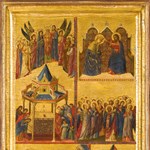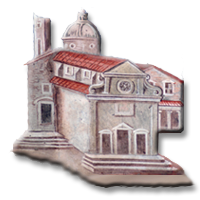Introduzione
Ala destra di un dittico con episodi dalle vite della Vergine e altri santi:
l'apoteosi di Sant'Agostino, L'incoronazione della Vergine, Caterina disputa con i filosofi, Francesco riceve le stimmate, Giovanni Battista nel deserto
Fonte: www.sothebys.com
This masterpiece was painted at the very dawn of the fourteenth century and is an extremely rare work by Giovanni da Rimini. It is among the very earliest Italian paintings to have been offered at auction. A very early follower of Giotto, to whom the panel was once attributed, Giovanni was undoubtedly one of the patriarchs in the relatively short-lived glory of Rimini’s school of painting in the first decades of the century. This jewel-like work is arguably the artist’s masterpiece, and it is difficult to overstate its importance as a bridge between the archaic style of the thirteenth century – still so dependent on static Byzantine models which until that moment had dominated painting in the peninsula – and the new, more recognizably Italian style bathed in emotion and perspective, which was pioneered by Giotto and which was to herald the innovations that led to the Renaissance. When Waagen (see Literature) saw the painting in 1854 he assumed it to be by Giotto's hand and described it thus: ‘...a relic of the most delicate kind, the heads fine, the motives very speaking, and the execution like the tenderest miniature...In excellent preservation’.
Roberto Longhi (see Literature) was the first to flesh out Giovanni da Rimini’s œuvre, with Brandi subsequently expanding it. First recorded in 1292, by 1300 Giovanni is referred to as a ‘maestro’ in Rimini. By the end of the thirteenth century Rimini was a small independent commune under the rule of the Malatesta family, but it was not to enjoy the wealth or verdant cultural scene from which Padua and Florence benefited until the fifteenth century. Nevertheless, the great Giotto was lured there to work for the cathedral of San Francesco, better known today as the Tempio Malatestiano. The chronicler Riccobaldo Ferrarese records that Giotto produced some superb frescoes which were most likely destroyed during the restructuring of San Francesco in 1450 but his spectacular Crucifix from just shortly before 1300 still hangs there (see fig. 1).
The date of Giotto’s stay in Rimini has been the matter of some debate, with some scholars proposing it to have post-dated his Paduan sojourn, which is generally accepted as starting after 1303. However, the date of 1309 on Giovanni's signedCrucifix in Mercatello (see fig. 2),1 so clearly dependent on Giotto’s work in the Tempio Malatestiano, strongly suggests that Giotto must have stopped in Rimini before moving on to Padua, where he was to work on the celebrated frescoes in the Cappella Scrovegni and where his colouring developed a more metallic hue, while his compositions became more daring. Moreover, among Giovanni’s most important works is the cycle of frescoes probably from the 1310s in the church of Sant’Agostino in Rimini in which the colouring and volume of the figures show to what extent Giovanni had absorbed Giotto’s pre-Paduan style; the frescoes were to prove defining for the Riminese school for some time after.
The Alnwick panel was originally the left wing of a diptych and narrates a selection of episodes from the lives of the Virgin and Saints. The right-hand panel (see fig. 3), now in the Galleria Nazionale d’Arte Antica in Rome, shows six episodes from the life of Christ. Placed side by side, the two identically-sized panels illustrate in a refined palette and with the care of a miniaturist some of the most popular and emotionally charged biblical and apocryphal scenes which presumably resonated most strongly with the Medieval believer. The present work was acquired in 1853 from the Camuccini collection, while the Rome panel was in the Sciarra collection until 1897. The early history of the paintings has not reached us but according to Barbieri in his catalogue of the Camuccini collection (see Literature), we know the Alnwick panel came from the Barberini collection. Since the Sciarra and Barberini families first intermarried in the eighteenth century, it is likely that the two leaves of the diptych were separated after a family division.2 The panels have been reunited only once, on the occasion of the 1995 landmark exhibition on fourteenth-century Riminese painting.
As was common in Romanesque panels in the Marches and in Umbria, the panels are divided into several small scenes. The Rome valve is separated into six distinct sections which are of equal size and flow in an ordered sequence from the birth of the Messiah, through to His death, Resurrection and ultimately to His seating on His throne in Heaven. The Northumberland panel, however, introduces a freer approach in both the disposition of the sections and in the choice of narrative episodes. While a very similar decorative band runs vertically through the centre of the Rome panel, in the present work it stops above the lower section of episodes, which is itself divided unevenly. The upper left section depicts the Apotheosis of Saint Augustine and is in fact made up of two quadrants extended vertically. This format creates room for the wonderfully inventive and modern temple, around which a crowd steps back in amazement as they see Augustine’s empty tomb, and allows the artist to successfully explore an early attempt at convincing perspectival solutions. Above them hovers an asymmetrical company of weightless saints and angels who surround the Virgin and Christ and welcome into their fold Augustine, seen in the centre wearing his mitre. Though the upper-right side of the panel appears to be in two sections, with a series of red crosses apparently splitting it horizontally, it is in fact a remarkably inspired reversal of the compositional layout of the Apotheosis scene: the celestial gathering of figures now appears below the focus of the scene, which in this case is the Crowning of the Virgin, rather than above it. The elegant temple, meanwhile, has been swapped for an extravagant throne so often found in Venetian painting. The lively and beautifully robed angels are again inventively irregular yet lyrically balanced in their arrangement; the central angel is even turned away and offers his back to the viewer in a wonderful early example of foreshortening in the depiction of the wings, another testament to the artist’s confident reworking of previous models.
The lower section borrows themes directly from the Saint Francis cycle of frescoes in Assisi which is generally attributed to Giotto. To the left, in the episode of The Dispute of Saint Catherine, Giovanni pays homage to the fresco of Saint Francis preaching to the Sultan (see fig. 4), both in the outstretched arms and in the architectural niche to the right. In the lower right section we see an unusual juxtaposition of Saints Francis and John the Baptist placed within a convincingly three-dimensional mountainous setting. Again, the figures of Francis receiving the stigmata and the winged cherub are lifted from the Assisi cycle (see fig. 5).
Alongside the date of 1309 on Giovanni’s Crucifix in Mercatello (fig. 2), on the basis of style works such as the Alnwick panel also lend weight to the fact that Giotto stopped in Rimini on his way to Padua – how else could artists from a relatively provincial centre such as Rimini have had access to Giotto’s designs and have been so overwhelmingly influenced so early on? Giotto’s arrival sped up immeasurably the stylistic development of the Riminese school, which subsequently plateaued fairly rapidly by the 1320s. Yet despite quickly absorbing Giotto’s modernizing tendencies, part of Giovanni’s charm and his significance to art history is that his thirteenth-century roots are inescapable: the elongated proportions of the MercatelloCrucifix and the archaic background decoration once again remind us of the Byzantine tradition which held sway over Italian painting, particularly on the Adriatic coast. Even within Giovanni’s own œuvre, his stylistic evolution is marked: possibly painted just before the Alnwick and Rome diptych, the Madonna and Child with Saints and Angels in Faenza (see fig. 6) blends a rigid and formal two-tiered structure with some startling and successful innovations, but still feels more archaic than the present work. The iconography is a development of the Byzantine Virgin Pelagonitissa, a stock type which showed the Virgin with the playing Child and which became popular in the twelfth and thirteenth centuries. While the lower tier presents the figures in a somewhat austere and evenly spaced arrangement, the Madonna and Child present a strong contrast, breaking free from the tradition that had preceded them and looking toward the more expressive solutions of the fourteenth century, particularly in their tender exchange and in the form of the contorted Child.
Vincenzo Camuccini (1771–1844) was the foremost neoclassical painter in Rome, President of the Academy of St Luke and Inspector-General of the Vatican Museums, and together with his brother Pietro (1760–1833), a prominent picture dealer and restorer, amassed a very considerable collection of works of art. The greater portion of the pictures, seventy four in number, were acquired by the Duke of Northumberland, and included such masterpieces as Raphael's Madonna of the Pinksin the National Gallery in London, and Bellini and Titian's Feast of the Gods now in the National Gallery in Washington. The sale was negotiated in 1853 by Antonio Giacinto Saverio, Count Cabral, who was Northumberland's attorney in Rome, and who had valued the collection in 1850 at £2,500. Letters in the Alnwick Castle archives indicate that the sale was originally brokered by the German Emil Braun.3 The sale was made with Vincenzo's son Giovanni Battista Camuccini (1819–1904), who subsequently bought a castle at Centalupo near Rome with the proceeds.
1. The Crucifix is signed and dated: IOHANNES PICTOR FECIT HOC OPUS FRATRI TOBALDI M.L.M.CCCVIIII.
2. The case is made all the more explicit when one takes into account that Palazzo Barberini is the name of the building of the Galleria Nazionale d’Arte Antica in Rome in which the Sciarra panel hangs.
3. See J. Anderson, ‘The Provenance of Bellini's Feast of the Gods and a New/Old Interpretation’, in Studies in the History of Art.45., Center for Advanced Study in the Visual Arts Symposium Papers, XXV, 1993, pp. 265–87.



